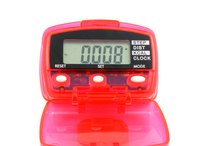Examples of a Food Diary
Writing down what you eat provides a complete picture of your dietary habits. This can help you lose weight, achieve specific eating goals or zero in on a potential food intolerance. The American Heart Association suggests writing down the times you eat, the foods, portion sizes and how you felt at the time of your meal. At the end of the day, review your food diary to see whether you met your goals and spot potential challenges.
Basic Food Diary
You can use a basic food diary if you're looking for a general picture of your eating habits, as it will help you identify areas of your diet that may need improvement. For example, it will give you an idea of whether you're getting enough fruits and vegetables. A basic food diary includes the day, the time and what you ate. For example: "8 a.m. Monday, breakfast -- 1 orange, 1 bowl of oatmeal and 1 glass of orange juice." Continue this pattern for each meal and snack.
Weight-Loss Diary
Sportline Heart Rate Watch Instructions
Learn More
Keeping a food diary is a proven method of promoting weight loss, according to Cleveland Clinic. In a weight-loss diary you provide details such as where you ate, specific serving sizes and calories, fat grams or other nutrient information. This gives you a picture of your overall caloric intake, holds you accountable and helps you spot certain patterns. For instance, you might notice that you eat more food when you're in front of the television or when you're stressed. If you have a turkey sandwich for lunch, your entry might be: "Noon Tuesday -- 2 slices of whole-wheat bread -- 2 ounces of turkey -- 1 teaspoon of mustard -- 2 slices of low-fat cheddar cheese." Use an online calorie calculator or add up the calories on the packaging to determine the meal's total calories. Don't forget about the calories in beverages, too.
Food Intolerance Diary
If you experience digestive symptoms after eating and suspect you may have a food intolerance, keeping a diary can help you determine which food is causing your symptoms. In a food intolerance diary, record the meals you eat and any symptoms you experience. For example, if you experience stomach cramps and gas after a snack of milk and cookies, your entry might look similar to this: "2 p.m. Monday -- 8 ounces of milk -- 3 shortbread cookies. 3 p.m. -- mild cramps and gas."
Organizing Your Food Diary
Weight-Loss Games for Groups
Learn More
It's crucial to organize your food diary so you can view the information clearly. Create spaces to record relevant information such as date, time, food eaten, quantity, feelings, location and, if it's a food intolerance diary, symptoms. Create a section for each category and leave blank spaces to separate each category. Be as detailed as possible and leave a space for additional notes. Obtaining a list of the calories for common foods and portions and recording your calorie intake can help if you're looking to reduce your calories. Experiment with a free application or website that allows you to create a digital food diary, figuring out which one has features that work best for your purposes.
Related Articles
References
Resources
Writer Bio
Janet Renee is a clinical dietitian with a special interest in weight management, sports dietetics, medical nutrition therapy and diet trends. She earned her Master of Science in nutrition from the University of Chicago and has contributed to health and wellness magazines, including Prevention, Self, Shape and Cooking Light.









